
- •Study Skills Workshop
- •1.1 An Introduction to the Whole Numbers
- •1.2 Adding Whole Numbers
- •1.3 Subtracting Whole Numbers
- •1.4 Multiplying Whole Numbers
- •1.5 Dividing Whole Numbers
- •1.6 Problem Solving
- •1.7 Prime Factors and Exponents
- •1.8 The Least Common Multiple and the Greatest Common Factor
- •1.9 Order of Operations
- •THINK IT THROUGH Education Pays
- •2.1 An Introduction to the Integers
- •THINK IT THROUGH Credit Card Debt
- •2.2 Adding Integers
- •THINK IT THROUGH Cash Flow
- •2.3 Subtracting Integers
- •2.4 Multiplying Integers
- •2.5 Dividing Integers
- •2.6 Order of Operations and Estimation
- •Cumulative Review
- •3.1 An Introduction to Fractions
- •3.2 Multiplying Fractions
- •3.3 Dividing Fractions
- •3.4 Adding and Subtracting Fractions
- •THINK IT THROUGH Budgets
- •3.5 Multiplying and Dividing Mixed Numbers
- •3.6 Adding and Subtracting Mixed Numbers
- •THINK IT THROUGH
- •3.7 Order of Operations and Complex Fractions
- •Cumulative Review
- •4.1 An Introduction to Decimals
- •4.2 Adding and Subtracting Decimals
- •4.3 Multiplying Decimals
- •THINK IT THROUGH Overtime
- •4.4 Dividing Decimals
- •THINK IT THROUGH GPA
- •4.5 Fractions and Decimals
- •4.6 Square Roots
- •Cumulative Review
- •5.1 Ratios
- •5.2 Proportions
- •5.3 American Units of Measurement
- •5.4 Metric Units of Measurement
- •5.5 Converting between American and Metric Units
- •Cumulative Review
- •6.2 Solving Percent Problems Using Percent Equations and Proportions
- •6.3 Applications of Percent
- •6.4 Estimation with Percent
- •6.5 Interest
- •Cumulative Review
- •7.1 Reading Graphs and Tables
- •THINK IT THROUGH The Value of an Education
- •Cumulative Review
- •8.1 The Language of Algebra
- •8.2 Simplifying Algebraic Expressions
- •8.3 Solving Equations Using Properties of Equality
- •8.4 More about Solving Equations
- •8.5 Using Equations to Solve Application Problems
- •8.6 Multiplication Rules for Exponents
- •Cumulative Review
- •9.1 Basic Geometric Figures; Angles
- •9.2 Parallel and Perpendicular Lines
- •9.3 Triangles
- •9.4 The Pythagorean Theorem
- •9.5 Congruent Triangles and Similar Triangles
- •9.6 Quadrilaterals and Other Polygons
- •9.7 Perimeters and Areas of Polygons
- •THINK IT THROUGH Dorm Rooms
- •9.8 Circles
- •9.9 Volume
- •Cumulative Review
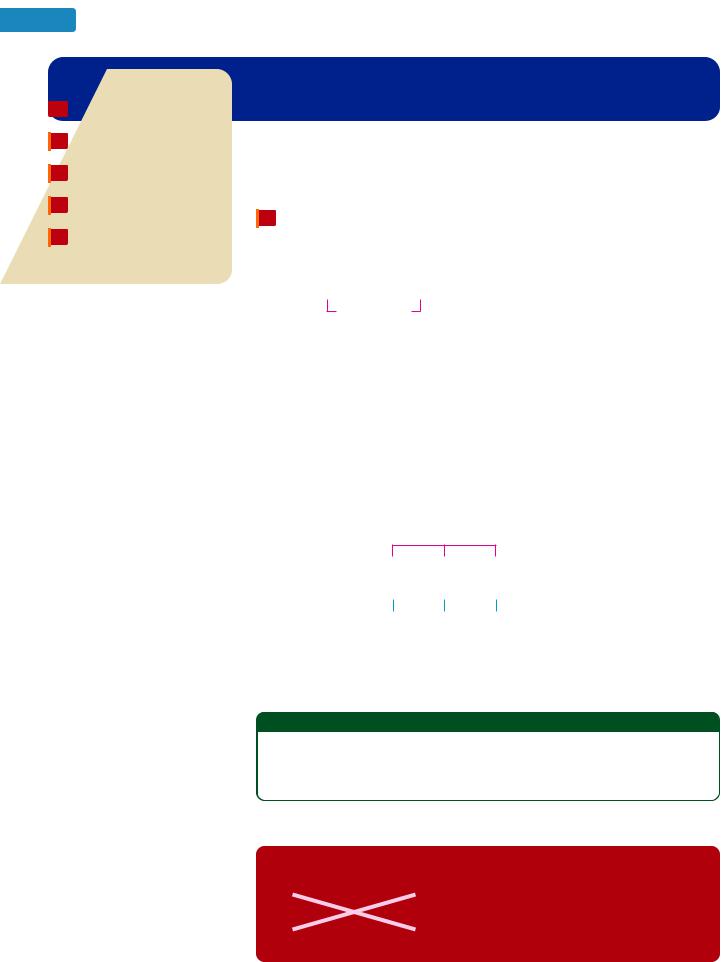
242 Chapter 3 Fractions and Mixed Numbers
|
|
Objectives |
S E C T I O N 3.4 |
|
|
Add and subtract fractions that |
Adding and Subtracting Fractions |
||
|
1 |
|||
|
|
have the same denominator. |
|
|
|
|
|
|
|
2Add and subtract fractions that have different denominators.
3Find the LCD to add and subtract fractions.
4Identify the greater of two fractions.
5Solve application problems by adding and subtracting fractions.
In mathematics and everyday life, we can only add (or subtract) objects that are similar. For example, we can add dollars to dollars, but we cannot add dollars to oranges. This concept is important when adding or subtracting fractions.
1 Add and subtract fractions that have the same denominator.
Consider the problem 35 15 . When we write it in words, it is apparent that we are adding similar objects.
three-fifths one-fifth
|
|
Similar objects
Because the denominators of 35 and 15 are the same, we say that they have a common denominator. Since the fractions have a common denominator, we can add them. The following figure explains the addition process.
|
three-fifths |
|
|
|
one-fifth |
|
|
|
four-fifths |
|
||||||
|
|
|
|
|
|
|
|
|
|
|
|
|
|
|
|
|
|
|
|
|
|
|
|
|
|
|
|
|
|
|
|
|
|
3 |
|
+ |
1 |
|
= |
4 |
|
|
||||||||
|
|
– |
|
|
– |
|
|
– |
|
|||||||
5 |
|
|
|
5 |
|
|
|
5 |
|
|
||||||
We can make some observations about the addition shown in the figure.
The sum of the numerators is the numerator of the answer.
|
|
|
|
|
|
|
|
3 |
|
1 |
|
4 |
|||
5 |
5 |
5 |
|||||
|
|
||||||
|
|
|
|
|
|
|
|
|
|
|
|
|
|
|
|
The answer is a fraction that has the same denominator as the two fractions that were added.
These observations illustrate the following rule.
Adding and Subtracting Fractions That Have the Same Denominator
To add (or subtract) fractions that have the same denominator, add (or subtract) their numerators and write the sum (or difference) over the common denominator. Simplify the result, if possible.
Caution! We do not add fractions by adding the numerators and adding the denominators!
3 |
|
1 |
|
3 |
1 |
|
4 |
5 |
5 |
5 |
5 |
10 |
The same caution applies when subtracting fractions.
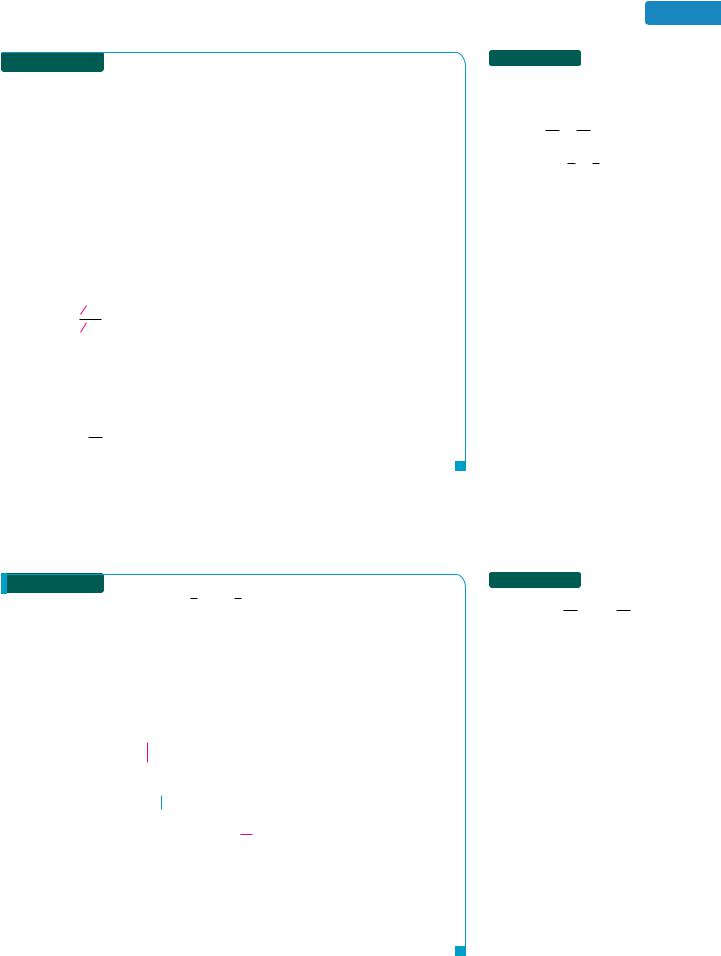
3.4 Adding and Subtracting Fractions |
243 |
|
EXAMPLE |
1 |
Perform each operation and simplify the result, if possible. |
|||||||
|
|
|
|
|
|
|||||
a. Add: |
1 |
|
5 |
|
b. Subtract: |
11 |
|
4 |
|
|
8 |
8 |
|
15 |
15 |
|
|||||
Strategy We will use the rule for adding and subtracting fractions that have the same denominator.
WHY In part a, the fractions have the same denominator, 8. In part b, the fractions have the same denominator, 15.
 Self Check 1
Self Check 1
Perform each operation and simplify the result, if possible.
a.Add: 125 121
b.Subtract: 89 19
Now Try Problems 17 and 21
Solution
a. |
1 |
|
5 |
|
1 5 |
|
8 |
8 |
8 |
||||
|
|
|
|
|
6 |
|
|
|
|
|
|
|
|
|
|
|
|
8 |
|
|
|
|
|
|
|
21 #3 |
|
|
|
|
|
|
2 #4 |
|
|
|
|
|
|
1 |
|
|
|
|
|
|
3 |
|
|
|
|
|
|
|
|
|
|
|
|
4 |
|
|
Add the numerators and write the sum over the common denominator 8.
This fraction can be simplified.
To simplify, factor 6 as 2 3 and 8 as 2 4. Then remove the common factor of 2 from the numerator and denominator.
Multiply the remaining factors in the numerator: 1 3 3. Multiply the remaining factors in the denominator: 1 4 4.
11 |
|
4 |
|
11 4 |
Subtract the numerators and write the difference |
|
b. |
|
|
|
|
|
over the common denominator 15. |
15 |
15 |
15 |
||||
157
Since 7 and 15 have no common factors other than 1,the result is in simplest form.
The rule for subtraction from Section 2.3 can be extended to subtraction involving signed fractions:
To subtract two fractions, add the first to the opposite of the fraction to be subtracted.
Subtract: 73 a 23b
Strategy To find the difference, we will apply the rule for subtraction.
WHY It is easy to make an error when subtracting signed fractions. We will probably be more accurate if we write the subtraction as addition of the opposite.
 Self Check 2
Self Check 2
Subtract: 119 a 113 b
Now Try Problem 25
Solution
We read 73 1 23 2as “negative seven-thirds minus negative two-thirds.” Thus, the number to be subtracted is 23 . Subtracting 23 is the same as adding its opposite, 23 .
|
|
|
|
|
|
|
Add |
|
|
|
|
|
|
|
|
|
|
|
|
7 |
|
|
2 |
|
7 |
|
|
|
2 |
||||||||
|
|
|
|
|
|
|
||||||||||||
|
|
|
|
|
|
|
|
|||||||||||
|
|
a |
|
b |
|
|
|
|
|
|||||||||
3 |
3 |
3 |
3 |
|||||||||||||||
|
|
|
|
|
|
the opposite |
|
|
|
|||||||||
|
|
|
|
|
|
|
|
|
|
|||||||||
|
|
|
|
|
|
|
|
|
|
|||||||||
|
|
|
|
|
7 |
|
|
2 |
|
|||||||||
|
|
|
|
|
|
|
|
|
|
|
||||||||
|
|
|
|
3 |
|
3 |
|
|||||||||||
|
|
|
|
|
7 2 |
|
||||||||||||
|
|
|
|
3 |
|
|
|
|
|
|||||||||
|
|
|
|
|
|
|
|
|
|
|
|
|
|
|||||
|
|
|
|
|
5 |
|
|
|
|
|
|
|
||||||
|
|
|
|
|
|
|
|
|
|
|
|
|
||||||
|
|
|
|
3 |
|
|
|
|
|
|
|
|||||||
|
|
|
|
|
|
|
|
|
5 |
|
|
|
|
|
|
|||
|
|
|
|
|
|
|
|
|
|
|
|
|
||||||
|
|
|
|
3 |
|
|
|
|
|
|
||||||||
Add the opposite of 32, which is 32 .
Write 37 as 37 .
Add the numerators and write the sum over the common denominator 3.
Use the rule for adding two integers with different signs: 7 2 5.
Rewrite the result with the sign in front:
This fraction is in simplest form.
5 5 .
3 3
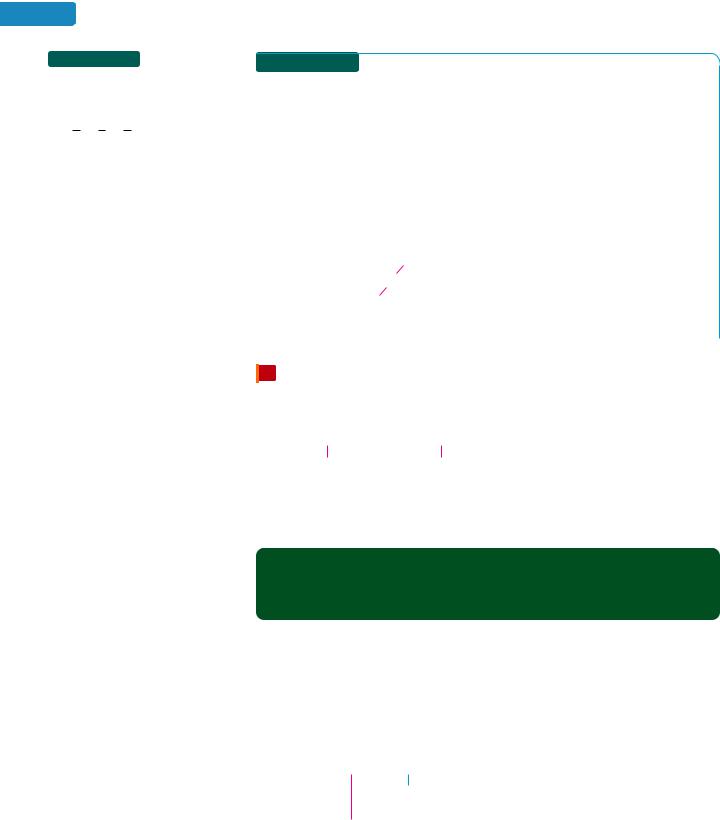
244 |
Chapter 3 Fractions and Mixed Numbers |
 Self Check 3
Self Check 3
Perform the operations and simplify:
29 29 29
Now Try Problem 29
|
EXAMPLE 3 |
18 |
|
2 |
|
1 |
|
Perform the operations and simplify: |
|
|
|||
|
25 |
25 |
25 |
|||
|
|
|
|
Strategy We will use the rule for subtracting fractions that have the same denominator.
WHY All three fractions have the same denominator, 25.
Solution
18 |
|
2 |
|
1 |
|
|
18 2 1 |
Subtract the numerators and write the difference |
|
||||
25 |
25 |
25 |
|
25 |
|
over the common denominator 25. |
|
||||||
|
|
|
|
|
|
|
15 |
|
|
This fraction can be simplified. |
|
||
|
|
|
|
|
|
25 |
|
|
|
||||
|
|
|
|
|
|
|
1 |
|
|
|
|
||
|
|
|
|
|
|
|
3 5 |
|
To simplify, factor 15 as 3 5 and 25 as 5 5. Then remove the |
|
|||
|
|
|
|
|
|
5 5 |
|
common factor of 5 from the numerator and denominator. |
|
||||
|
|
|
|
|
|
|
|
|
|||||
|
|
|
|
|
|
|
1 |
|
|
|
|
|
|
|
|
|
|
|
|
|
3 |
|
|
|
Multiply the remaining factors in the numerator: 3 1 3. |
|
|
|
|
|
|
|
|
5 |
|
|
|
Multiply the remaining factors in the denominator: 1 5 5. |
|
||
|
|
|
|
|
|
|
|
|
|
||||
|
|
|
|
|
|
|
|
|
|
|
|||
2 Add and subtract fractions that have different denominators.
Now we consider the problem 35 13 . Since the denominators are different, we cannot add these fractions in their present form.
three-fifths |
|
one-third |
||||
|
|
|
|
|
|
|
|
|
Not similar objects |
|
|
||
|
|
|
||||
To add (or subtract) fractions with different denominators, we express them as equivalent fractions that have a common denominator. The smallest common denominator, called the least or lowest common denominator, is usually the easiest common denominator to use.
Least Common Denominator
The least common denominator (LCD) for a set of fractions is the smallest number each denominator will divide exactly (divide with no remainder).
The denominators of 35 and 13 are 5 and 3. The numbers 5 and 3 divide many numbers exactly (30, 45, and 60, to name a few), but the smallest number that they divide exactly is 15. Thus, 15 is the LCD for 35 and 13 .
To find 35 13 , we build equivalent fractions that have denominators of 15. (This procedure was introduced in Section 3.1.) Then we use the rule for adding fractions
that have the same denominator. |
|
|
|
||||||||||||||||||||||
|
3 |
|
1 |
|
|
3 |
|
|
3 |
|
|
|
1 |
|
|
5 |
|
|
|
|
|
||||
5 |
|
3 |
|
5 |
3 |
|
|
|
|
3 |
|
|
5 |
|
|
|
|
|
|||||||
|
|
|
|
|
|
|
|
1 |
|
|
|
|
1 We need to multiply this denominator by 5 to obtain 15. |
||||||||||||
|
|
|
|
|
|
|
|
|
|
|
|
|
|
|
|
|
|
|
|
|
|
It follows that 5 should be the form of 1 used to build |
1 |
. |
|
|
|
|
|
|
|
|
|
|
|
|
|
|
|
|
|
|
|
|
|
|
|
||||
|
|
|
|
|
|
|
|
|
|
|
|
|
|
|
|
|
|
|
|
|
|
|
|||
|
|
|
|
|
|
|
|
|
|
|
|
|
|
|
|
|
|
|
5 |
3 |
|
||||
|
|
|
|
|
|
|
|
|
|
|
|
|
|
|
|
|
|
|
We need to multiply this denominator by 3 to obtain 15. |
|
|
|
|||
|
|
|
|
|
|
|
|
|
|
|
|
|
|
|
|
|
|
|
It follows that 3 should be the form of 1 that is used to build |
3 . |
|
||||
|
|
|
|
|
|
|
|
|
|
|
|
|
|
|
|
|
|
|
|||||||
|
|
|
|
|
|
|
|
|
|
|
|
|
|
|
|
|
|
|
3 |
5 |
|
||||
|
|
|
|
|
9 |
|
|
5 |
|
|
|
|
|
|
Multiply the numerators. Multiply the denominators. |
|
|
|
|||||||
|
|
|
|
15 |
15 |
|
|
|
|
|
Note that the denominators are now the same. |
|
|
|
|||||||||||
|
|
|
|
|
9 5 |
|
|
|
|
|
|
|
|
Add the numerators and write the sum |
|
|
|
||||||||
|
|
|
|
15 |
|
|
|
|
|
|
|
|
|
over the common denominator 15. |
|
|
|
||||||||
|
|
|
|
|
|
|
|
|
|
|
|
|
|
|
|
|
|||||||||
|
|
|
|
|
14 |
|
|
|
|
|
|
|
|
|
|
|
Since 14 and 15 have no common factors other |
|
|
|
|||||
|
|
|
|
15 |
|
|
|
|
|
|
|
|
|
|
|
than 1, this fraction is in simplest form. |
|
|
|
||||||

3.4 Adding and Subtracting Fractions |
245 |
The figure below shows 35 and 13 expressed as equivalent fractions with a denominator of 15. Once the denominators are the same, the fractions are similar objects and can be added easily.
3 |
|
|
|
|
|
|
|
|
1 |
|
|
|
|
|
|
|
|
|
|
|
|
|
|
|
|
|
|
|
|
|
|
|
||||||||||||||
|
|
|
|
|
|
|
– |
|
|
|
|
|
|
|
|
|
|
|
|
|
|
– |
|
|
|
|
|
|
|
|
|
|
|
|
|
|
|
|
|
|
|
|
|
|
||
5 |
|
|
|
|
|
|
|
|
3 |
|
|
|
|
|
|
|
|
|
|
|
|
|
|
|
|
|
|
|
|
|
|
|
||||||||||||||
|
|
|
|
|
|
|
|
|
|
|
|
|
|
|
|
|
|
|
|
|
|
|
|
|
|
|
|
|
|
|
|
|
|
|
|
|
|
|
|
|
|
|
|
|
|
|
|
|
|
|
|
|
|
|
|
|
|
|
|
|
|
|
|
|
|
|
|
|
|
|
|
|
|
|
|
|
|
|
|
|
|
|
|
|
|
|
|
|
|
|
|
|
|
9 |
|
+ |
5 |
|
= |
14 |
|
|
|
|
|
|
||||||||||||||||||||||||||||||||||
|
|
|
|
|
|
–– |
|
|
|
|
|
|
–– |
|
|
|
|
|
|
|
–– |
|
|
|
|
|
|
|||||||||||||||||||
15 |
|
|
|
|
|
|
|
15 |
|
|
|
|
|
|
|
15 |
|
|
|
|
|
|
||||||||||||||||||||||||
We can use the following steps to add or subtract fractions with different denominators.
Adding and Subtracting Fractions That Have Different Denominators
1.Find the LCD.
2.Rewrite each fraction as an equivalent fraction with the LCD as the denominator. To do so, build each fraction using a form of 1 that involves any factors needed to obtain the LCD.
3.Add or subtract the numerators and write the sum or difference over the LCD.
4.Simplify the result, if possible.
1 2 Add: 7 3
Strategy We will express each fraction as an equivalent fraction that has the LCD as its denominator. Then we will use the rule for adding fractions that have the same denominator.
WHY To add (or subtract) fractions, the fractions must have like denominators.
Solution
Since the smallest number the denominators 7 and 3 divide exactly is 21, the LCD is 21.
|
|
|
|
|
1 1 |
||||||
1 |
|
2 |
|
1 |
|
3 |
|
2 |
|
7 |
|
7 |
3 |
7 |
3 |
3 |
7 |
|
|||||
|
|
|
|
|
|
||||||
213 1421
3 14
21
To build 71 and 32 so that their denominators are 21, multiply each by a form of 1.
Multiply the numerators. Multiply the denominators. The denominators are now the same.
Add the numerators and write the sum over the common denominator 21.
Since 17 and 21 have no common factors other than 1, this fraction is in simplest form.
 Self Check 4
Self Check 4
Add: 12 25
Now Try Problem 35
5 7 Subtract: 2 3
Strategy We will express each fraction as an equivalent fraction that has the LCD as its denominator. Then we will use the rule for subtracting fractions that have the same denominator.
 Self Check 5
Self Check 5
Subtract: 67 35
Now Try Problem 37
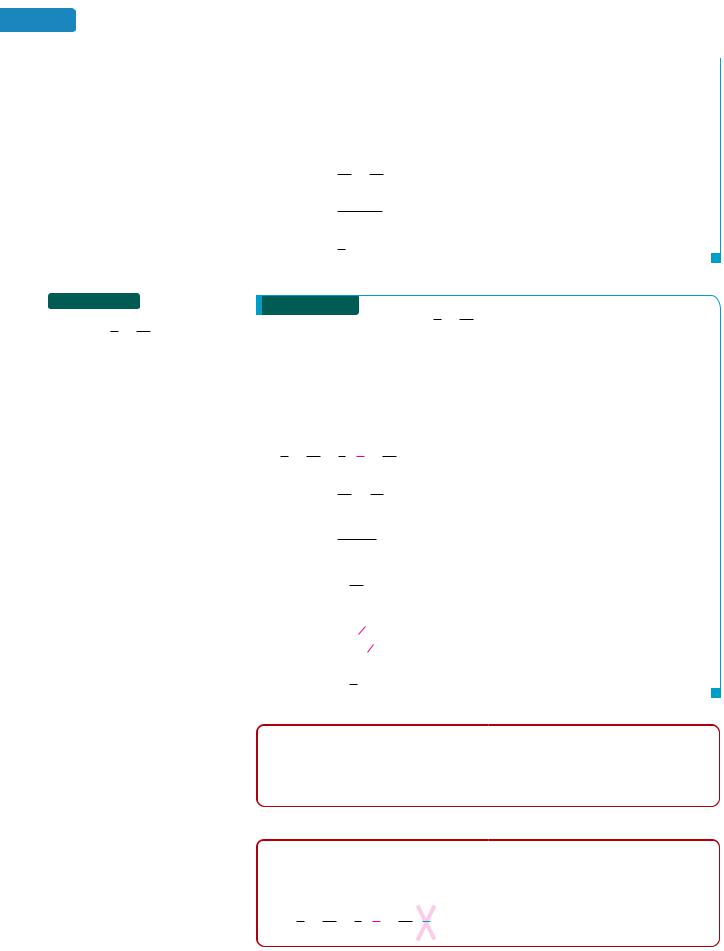
246 |
Chapter 3 Fractions and Mixed Numbers |
WHY To add (or subtract) fractions, the fractions must have like denominators.
Solution
Since the smallest number the denominators 2 and 3 divide exactly is 6, the LCD is 6.
|
|
|
|
|
1 1 |
||||||
5 |
|
7 |
|
5 |
|
3 |
|
7 |
|
2 |
|
2 |
3 |
2 |
3 |
3 |
2 |
|
|||||
|
|
|
|
|
|
||||||
156 146
15 14
6
To build 52 and 37 so that their denominators are 6, multiply each by a form of 1.
Multiply the numerators. Multiply the denominators. The denominators are now the same.
Subtract the numerators and write the difference over the common denominator 6.
This fraction is in simplest form.
 Self Check 6
Self Check 6
Subtract: 23 136
Now Try Problem 41
2 11 Subtract: 5 15
Strategy Since the smallest number the denominators 5 and 15 divide exactly is 15, the LCD is 15. We will only need to build an equivalent fraction for 25 .
WHY We do not have to build the fraction 1115 because it already has a denominator of 15.
Solution
25 1115 25 33 1115156 1115
6 11
15
155
To build 52 so that its denominator is 15, multiply it by a form of 1.
Multiply the numerators. Multiply the denominators. The denominators are now the same.
Subtract the numerators and write the difference over the common denominator 15.
If it is helpful, use the subtraction rule and add the opposite in the numerator: 6 ( 11) 5.
Write the sign in front of the fraction.
1
|
5 |
3 5 |
|
|
1 |
13
To simplify, factor 15 as 3 5. Then remove the common factor of 5 from the numerator and denominator.
Multiply the remaining factors in the denominator: 3 1 3.
Success Tip In Example 6, did you notice that the denominator 5 is a factor of the denominator 15, and that the LCD is 15. In general, when adding (or subtracting) two fractions with different denominators, if the smaller denominator is a factor of the larger denominator, the larger denominator is the LCD.
Caution! You might not have to build each fraction when adding or subtracting fractions with different denominators. For instance, the step in blue shown below is unnecessary when solving Example 6.
25 1115 25 33 1115 11

3.4 Adding and Subtracting Fractions |
247 |
Add: 5 34
Strategy We will write 5 as the fraction 15 . Then we will follow the steps for adding fractions that have different denominators.
WHY The fractions 15 and 34 have different denominators.
Solution
Since the smallest number the denominators 1 and 4 divide exactly is 4, the LCD is 4.
5 34 15 34
15 44 34
20 3 4 4
20 3 4
17
4174
Write 5 as 15 .
To build 15 so that its denominator is 4, multiply it by a form of 1.
Multiply the numerators. Multiply the denominators. The denominators are now the same.
Add the numerators and write the sum over the common denominator 4.
Use the rule for adding two integers with different signs:20 3 17.
17 17
Write the result with the sign in front: 4 4 .
This fraction is in simplest form.
 Self Check 7
Self Check 7
Add: 6 38
Now Try Problem 45
3 Find the LCD to add and subtract fractions.
When we add or subtract fractions that have different denominators, the least common denominator is not always obvious. We can use a concept studied earlier to determine the LCD for more difficult problems that involve larger denominators. To illustrate this, let’s find the least common denominator of 38 and 101 . (Note, the LCD is not 80.)
We have learned that both 8 and 10 must divide the LCD exactly. This divisibility requirement should sound familiar. Recall the following fact from Section 1.8.
The Least Common Multiple (LCM)
The least common multiple (LCM) of two whole numbers is the smallest whole number that is divisible by both of those numbers.
Thus, the least common denominator of 38 and 101 is simply the least common multiple of 8 and 10.
We can find the LCM of 8 and 10 by listing multiples of the larger number, 10, until we find one that is divisible by the smaller number, 8. (This method is explained in Example 2 of Section 1.8.)
Multiples of 10: 10, 20, 30, 40, 50, 60, . . .
This is the first multiple of 10 that is divisible by 8 (no remainder).
Since the LCM of 8 and 10 is 40, it follows that the LCD of 38 and 101 is 40.
We can also find the LCM of 8 and 10 using prime factorization. We begin by prime factoring 8 and 10. (This method is explained in Example 4 of Section 1.8.)
8 2 2 2
10 2 ~5

248 |
Chapter 3 Fractions and Mixed Numbers |
 Self Check 8
Self Check 8
Add: 18 56
Now Try Problem 49
The LCM of 8 and 10 is a product of prime factors, where each factor is used the greatest number of times it appears in any one factorization.
•We will use the factor 2 three times, because 2 appears three times in the factorization of 8. Circle 2 2 2, as shown on the previous page.
•We will use the factor 5 once, because it appears one time in the factorization of 10. Circle 5 as shown on the previous page.
Since there are no other prime factors in either prime factorization, we have
Use 2 three times.
Use 5 one time.
|
|
LCM (8, 10) 2 2 2 5 40
Finding the LCD
The least common denominator (LCD) of a set of fractions is the least common multiple (LCM) of the denominators of the fractions. Two ways to find the LCM of the denominators are as follows:
•Write the multiples of the largest denominator in increasing order, until one is found that is divisible by the other denominators.
•Prime factor each denominator. The LCM is a product of prime factors, where each factor is used the greatest number of times it appears in any one factorization.
Add: 157 103
Strategy We begin by expressing each fraction as an equivalent fraction that has the LCD for its denominator. Then we use the rule for adding fractions that have the same denominator.
WHY To add (or subtract) fractions, the fractions must have like denominators.
Solution
To find the LCD, we find the prime factorization of both denominators and use each prime factor the greatest number of times it appears in any one factorization:
15 3 5 |
|
|
|
2 appears once in the factorization of 10. |
|
3 |
5 |
30 |
3 appears once in the factorization of 15. |
||
~~fLCD 2 |
|||||
10 2 5 |
|
|
|
5 appears once in the factorizations of 15 and 10. |
|
~ |
|
|
|
The LCD for |
7 |
|
and |
|
|
3 |
is 30. |
|
||||||||
|
15 |
|
10 |
|
||||||||||||
7 |
|
3 |
|
|
7 |
|
2 |
|
3 |
|
3 |
|||||
|
|
|
|
|
|
|
|
|
|
|||||||
15 |
10 |
|
15 |
2 |
10 |
3 |
||||||||||
1430 309
14 9
30
2330
7 3
To build 15 and 10 so that their denominators are 30, multiply each by a form of 1.
Multiply the numerators. Multiply the denominators. The denominators are now the same.
Add the numerators and write the sum over the common denominator 30.
Since 23 and 30 have no common factors other than 1, this fraction is in simplest form.

3.4 Adding and Subtracting Fractions |
249 |
Subtract and simplify: 1328 211
Strategy We begin by expressing each fraction as an equivalent fraction that has the LCD for its denominator. Then we use the rule for subtracting fractions with like denominators.
WHY To add (or subtract) fractions, the fractions must have like denominators.
Solution
To find the LCD, we find the prime factorization of both denominators and use each prime factor the greatest number of times it appears in any one factorization:
 Self Check 9
Self Check 9
Subtract and simplify: 2156 409
Now Try Problem 53
28 ~2 2 ~7 fLCD 2 2 3 7 84 21 3 7
2 appears twice in the factorization of 28.
3 appears once in the factorization of 21.
7 appears once in the factorizations of 28 and 21.
The LCD for 1328 and 211 is 84.
We will compare the prime factorizations of 28, 21, and the prime factorization of the LCD, 84, to determine what forms of 1 to use to build equivalent fractions for 1328 and 211 with a denominator of 84.
LCD |
2 2 |
3 |
7 |
|
LCD 2 2 |
3 7 |
|
|||
|
|
|||||||||
Cover the prime factorization of 28. |
Cover the prime factorization of 21. |
|||||||||
Since 3 is left uncovered, |
Since 2 2 4 is left uncovered, |
|||||||||
use 3 to build |
13 |
. |
|
|
use 4 to build |
1 |
. |
|
||
28 |
|
|||||||||
3 |
|
|
|
|
|
4 |
21 |
|
||
1328 211 1328 33 211 44
3984 844
39 4
84
3584
1
5 72 2 3 7
1
125
13 1
To build 28 and 21 so that their denominators are 84, multiply each by a form of 1.
Multiply the numerators. Multiply the denominators. The denominators are now the same.
Subtract the numerators and write the difference over the common denominator.
This fraction is not in simplest form. |
|
|
|
To simplify, factor 35 and 84. Then |
|
84 |
|
|
|
||
remove the common factor of 7 from |
|
2 42 |
|
the numerator and denominator. |
|
~ |
|
|
|
~ |
21 |
Multiply the remaining factors in the |
|
2 |
|
|
3 |
7 |
|
numerator: 5 1 5. Multiply the |
|
||
|
~ ~ |
||
remaining factors in the denominator: 2 2 3 1 12.
4 Identify the greater of two fractions.
If two fractions have the same denominator, the fraction with the greater numerator is the greater fraction.
For example,
7 |
|
3 |
because 7 3 |
|
1 |
|
2 |
because 1 2 |
|
8 |
8 |
3 |
3 |
||||||
|
|
|
|
|
If the denominators of two fractions are different, we need to write the fractions with a common denominator (preferably the LCD) before we can make a comparison.
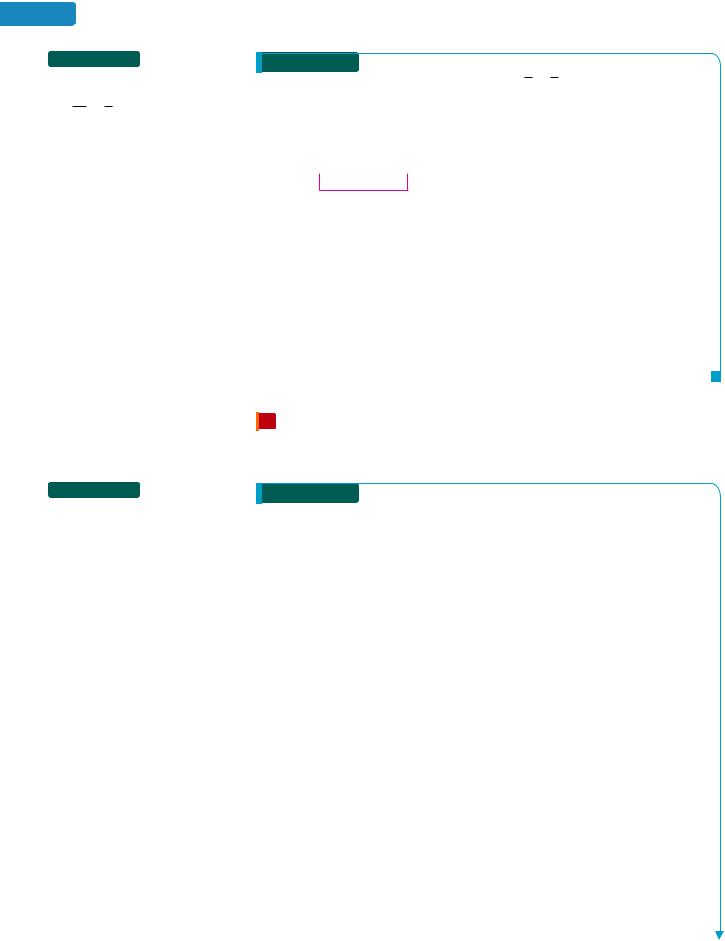
250 |
Chapter 3 Fractions and Mixed Numbers |
 Self Check 10
Self Check 10
Which fraction is larger: 127 or 35 ?
Now Try Problem 61
Which fraction is larger: 56 or 78 ?
Strategy We will express each fraction as an equivalent fraction that has the LCD for its denominator. Then we will compare their numerators.
WHY We cannot compare the fractions as given. They are not similar objects.
five-sixths seven-eighths
|
|
Solution
Since the smallest number the denominators will divide exactly is 24, the LCD for 56 and 78 is 24.
5 |
|
5 |
|
|
4 |
|
|
7 |
|
7 |
|
|
3 |
To build 65 and |
7 |
so that their denominators |
|
|
|
|
8 |
||||||||||||
6 |
6 |
4 |
|
|
8 |
8 |
3 |
are 24, multiply each by a form of 1. |
||||||||
|
|
20 |
|
|
|
|
|
|
21 |
|
|
Multiply the numerators. |
||||
|
24 |
|
|
|
|
|
24 |
|
|
Multiply the denominators. |
||||||
Next, we compare the numerators. Since 21 20, it follows that 2124 is greater than 2024 . Thus, 78 56 .
5Solve application problems by adding and subtracting fractions.
 Self Check 11
Self Check 11
Refer to the circle graph for Example 11. Find the fraction of the student body that watches 2 or more hours
of television daily.
Now Try Problems 65 and 109
|
No TV |
4 or more |
|
hours |
|
|
1 |
|
1 hour |
1 |
|
– |
–– |
|
1 |
6 |
30 |
|
1 |
|
– |
|
|
4 |
3 hours |
–– |
|
12 |
|
|
2 hours |
|
|
7 |
|
|
–– |
|
|
15 |
|
Television Viewing Habits Students on a college
campus were asked to estimate to the nearest hour how much television they watched each day. The results are given in the circle graph below (also called a pie chart). For example, the chart tells us that 14 of those responding watched 1 hour per day. What fraction of the student body watches from 0 to 2 hours daily?
Analyze
• 61 |
of the student body watches no TV daily. |
Given |
|||
• 41 |
of the student body watches 1 hour of TV daily. |
Given |
|||
• |
7 |
|
of the student body watches 2 hours of TV daily. |
Given |
|
15 |
|||||
|
|
|
|||
• |
What fraction of the student body watches 0 to 2 hours of TV daily? |
Find |
|||
Form We translate the words of the problem to numbers and symbols.
The fraction |
|
|
|
|
|
|
|
|
|
|
|
|
of the student |
|
|
|
|
|
the fraction |
|
the fraction |
||||
|
the fraction |
|
|
|||||||||
body that |
|
|
that watches |
|
that watches |
|||||||
is equal to |
that watches |
plus |
plus |
|||||||||
watches from |
|
no TV daily |
|
1 hour of |
|
2 hours of |
||||||
0 to 2 hours |
|
|
TV daily |
|
TV daily. |
|||||||
|
|
|
|
|
|
|||||||
of TV daily |
|
|
|
|
|
|
|
|
|
|
|
|
The fraction |
|
|
|
|
|
|
|
|
|
|
|
|
of the student |
|
|
|
|
|
|
|
|
|
|
|
|
body that |
= |
1 |
+ |
1 |
|
+ |
7 |
|
||||
|
|
|
|
|
|
|
|
|
||||
watches from |
6 |
4 |
|
15 |
|
|||||||
|
|
|
|
|
|
|||||||
0 to 2 hours of TV daily
